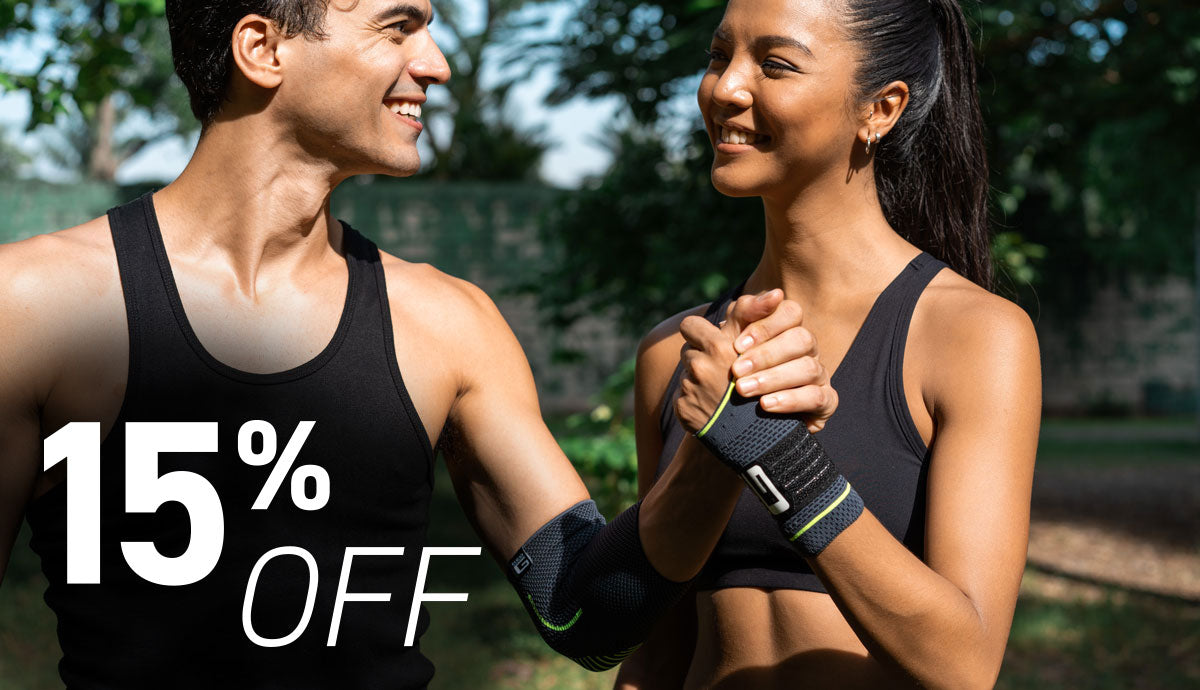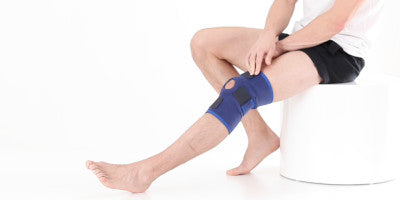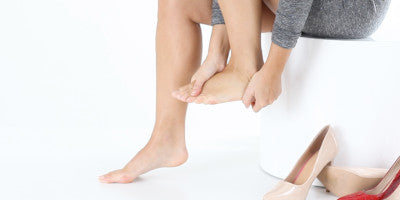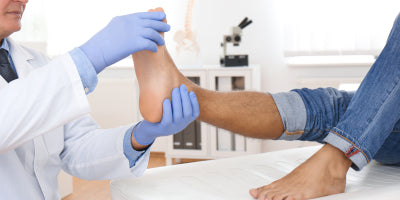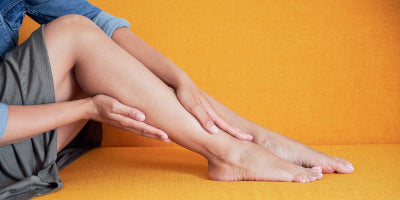Can Compression Help Prevent Deep Vein Thrombosis?

Many of us will have heard of the term Deep Vein Thrombosis (DVT), especially if you have been on long haul flights, but what is one and how can certain compression devices help reduce the risk of developing DVT? In our latest article we aim to answer some common questions that we have been asked.
What is DVT?
DVT stands for deep vein thrombosis and relates to a blood clot in a vein. These clots can occur in many parts of the body, but usually you will hear of a DVT in the lower leg. A DVT will develop when the blood thickens and clumps together, forming a clot. It’s possible for the clot to break off and travel through your bloodstream, lodging in other parts of your body, such as the lungs, and can be deadly. If you have any of the below symptoms you need to urgently get medical help.
Symptoms of a DVT in the leg are [1]:
- throbbing or cramping pain in one leg (rarely both legs), usually in the calf or thigh
- swelling in one leg (rarely both legs)
- warm skin around the painful area
- red or darkened skin around the painful area
- swollen veins that are hard or sore when you touch them
If you have symptoms as above as well as chest pain or shortness of breath, then you urgently need to get to hospital as this could be a life threatening pulmonary embolism.
What causes DVT?

Fig 1: Those on long journeys are at a higher risk of developing a DVT
Anyone can develop a DVT but there are several factors that will increase your risk of developing one. These factors can be broken down into lifestyle and specific long term conditions that will always put you at risk of a DVT, and situational factors that will temporarily increase your risk of developing a DVT.
Lifestyle and specific long term conditions include:
- Aged over 60 and/or being overweight - This risk may be due to blood flow being weaker or can be down to typically moving less.
- Smoking -This will increase risks of many conditions not just DVTs due to adaptations that occur in the body.
- Specific health conditions - Cancer will typically increase clotting of the blood therefore increasing risks of DVTs. Other health conditions that impact blood flow such as heart disease can also have an impact on the risk of developing a DVT.
- Previous medical history of DVT - If you have previously had a blood clot that has resulted in a DVT then you are more likely to develop another. This also applies to having a family history of developing DVTs
Temporary situations where you are more at risk include:
- Hospital stay or confined to a bed - If you are confined to a bed either in hospital or at home, then you are less likely to be moving around. If you have also had surgery, any damage to veins either before or during surgery can increase the risk of DVT occurring.
- Long journeys or being static in a confined space - Going on long journeys typically over three hours in length can increase your risk of DVT. Usually this will be down to not being able to move much during these journeys. These journeys will usually be by plane, car or train where you are likely to be in the same confined position.
What is compression and how does it work?
Compression can be used for several conditions and scenarios, but one that can be extremely useful is in reducing the risk of developing a DVT. Compression can come from many sources such as bandages and various wrap systems but most commonly you will see compression socks being used.

Fig 2: (Left to Right) a healthy vein, an unhealthy vein where values malfunction allowing a backflow of blood, a vein under compression where valves are pushed together increasing blood flow velocity.
Compression socks come in a various styles, lengths and compression levels but ultimately work in the same way. By providing a firm continuous pressure to the muscles and veins in the leg with more pressure being exerted at the ankle, blood is encouraged to flow up the leg. By helping blood flow back towards the heart, the compression socks support the natural function of the valves in the veins and therefore reduce the occurrence of blood pooling in the lower extremities. If blood pooling was to occur in individuals who were already at a greater risk, blood clots would form easily and therefore improving blood flow is particularly important for these individuals.
What is the correct compression sock size for me?

Fig 3: Typically measured areas for compression socks.
Compression socks come in various styles such as open/closed toe, below knee or thigh/full length stockings. The actual style you use may be determined by a medical professional if they have been provided following a hospital visit, however generally it will be personal preference for which style of sock you use, providing issues are in the lower leg. Any issues above the knee will require a thigh high stocking as a minimum length.
When it comes to the amount of compression required always look at the mmHg level indicated on the stockings if comparing brands as different brands can indicate mild, moderate and firm compression throughout their range of products. The compression level can either be indicated as a range or as a single number and this relates to the pressure that is exerted at the ankle. The NHS website[2] states a pressure of 14-17mmHg is generally sufficient to prevent DVT during travel. However, depending on your risk factors, you may require further compression, so if you are ever in doubt it is always best to speak to a medical professional.
If you are already receiving treatment following a diagnosis of DVT, then your stockings' compression levels, as recommended by your doctor, will likely be much higher than the 14-17mmHG level used for prevention.
It is extremely important to look at the manufacturers' size charts as they can differ from each other. By wearing a size too small, you can cause more harm and increase the risk of complications due to excessive compression potentially restricting blood flow. Each manufacturer may ask for measurements in different areas, but generally the two main areas you should measure are:
- The narrowest part of your ankle
- The widest part of your calf
For stockings above the knee you should also take a measurement in the thigh area at the point where the socks would ideally be reaching. Some manufacturers will also offer different lengths of sock so they may advise measuring from the heel to a certain point on the leg. If a manufacturer suggests measuring this length it is advisable to do so, as it is more likely the compression will be applied correctly to the key areas e.g. highest compression at the ankle.
As our bodies come in different shapes and sizes, you may find that one measurement falls into one particular size and the other falls into a size up or down. If you are fitting for yourself, we would suggest trying the larger size first, as you are less likely to cause any restriction. However, if you are being fitted by a medical professional they will use their clinical judgement for your individual needs.
One tip would be not to look at quick guides based on shoe sizes, as this can easily give inaccurate sizing for individuals, especially if you have large feet but a small ankle. Particular attention should be made to the ankle measurement, as this area will be the tightest part of the compression sock. Therefore, if you have wide feet, it is important that the sock has enough stretch to allow your foot to pass through while still providing adequate compression and not being overly tight.
How to put on compression socks
Compression socks can be a little difficult to get on, so below are some tips on ways to make it easier, but as always, read the manufacturer's guide on how to apply, as these could differ between brands.
- It is generally advised to only wear stockings during the day, so applying your stockings first thing will help, as you have likely had your feet either raised of level during the night, which will help reduce swelling in the feet.
- Turn the sock inside out leaving just the toe and heel area in a small pocket. This should ensure that the toe and heel can be placed in the correct position. If using open toe socks then you will only need to ensure the heel area is in the correct position. The Neo G travel & flight compression socks have a specific heel cup to help with accurate positioning. Ensure the heel is fully in this area.
- Once the toe and heel are positioned correctly, start by rolling the sock up your leg, ensuring that the sock is smooth all the way up the leg; any ridges can cause extra pressure to that point.

Fig 4: How to put on Compression socks.
In addition to these tips, you may find that some manufacturers of open toe socks or stockings include an application sock, which can go over the foot while you are applying the sock. This reduces friction, making it easier to apply the sock over the foot and ankle area, which is usually the most difficult.
Medical Grade Compression Help to ease symptoms of tired, aching or swollen legs. Constructed from specialist material for comfort, softness and breathability. Find out more here.

For support in everyday activities, the Airflow and Airflow+ ranges offer lightweight, slimline supports that protect and reduce the impact on joints and muscles. Perfect for taking a walk, playing sport or support with day to day strain.
Our Active range of knitted supports provide a snug, yet flexible fit during sporting and occupational activities. Multi Zone Compression surrounds muscles and joints for targeted support and the multi-way stretch allows flexible and safe movement, providing comfortable support and reducing the likelihood of injury. The specialist breathable fabric helps control moisture during intense activities, whilst the slimline, lightweight design means it can easily be worn under clothes for everyday wear.
Sources
[1]https://www.nhs.uk/conditions/deep-vein-thrombosis-dvt/
[2] https://www.nhs.uk/live-well/healthy-body/prevent-dvt-when-you-travel/
